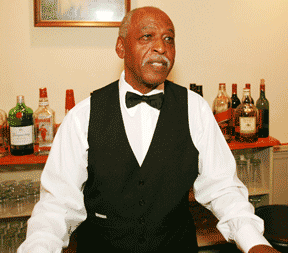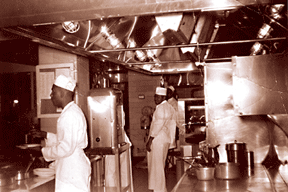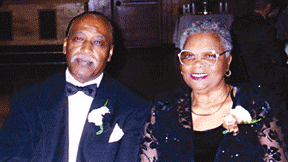|
|
 |
|||||||||
|
|||||||||||
|
|||||||||||
A Life of Work and a Birthday Reprieve
This Labor Day Marks 80 Years for Annapolitan Elroy JohnsonBy Ginger Doyel, special to Bay WeeklyAnnapolis was a different town when a midwife delivered Elroy Johnson on September 3, 1927. It was a smaller town with about 12,500 residents. It was, he says, a “slower town” where “you could play ball in the street without worrying about cars.” And it was a segregated town, which is partly why Johnson was delivered by a midwife, instead of in a hospital. “That’s how a lot of black ladies had their babies then,” Johnson said. “Things were tight, so my mother worked to help our family even when she was pregnant. She was picking beans in her parents’ field when she went into labor. I don’t think they had a phone, so someone must have gone for the midwife. Mother didn’t know she was carrying twins, me and my sister Rosalie!” Johnson grew up on Larkin Street, now City Gate Lane, in a home owned by his stepfather, Harvey McDowell. “My real father died and mother married Harvey when I was three,” he said. “Harvey was from West Virginia. But there was no work there, so he came here to look for a job. He found one as library custodian at the Naval Academy and did that for over 30 years, making $13.90 a week. “Larkin Street was a nice place to grow up,” Johnson recalled. “We knew our neighbors — the Browns, the Spencers, the Watkins, and the Hopkins — and we could walk to Stanton School. We had seven grades there, no eighth grade, and Philip Brown [the now 98-year-old activist and historian] was one of my teachers. He was also my homeroom teacher at Bates.”
Earning Your Keep EarlyJohnson worked while attending Stanton School and Wiley H. Bates High School. “The 1930s and ’40s were tough,” he said. “You had to earn your keep early. I got my first job when I was 12. I made a wagon out of a box and baby carriage wheels, stood outside the local grocery stores, and asked if I could carry folks’ groceries home for a nickel or dime. It was a good business.” Delivering groceries wasn’t Johnson’s only boyhood job. He worked at Max Snyder’s shoe store on West Street as well. “I sold shoes, kept it clean and when it wasn’t busy, I helped Mrs. Snyder at their home on Cathedral Street. I made 25 cents an hour for gardening and housework,” he said. The young Johnson also worked at Carr’s Beach. “During the summer, my friends and I made $5 a day as handymen at Carr’s,” he said. “We’d go early in the morning and get back at 10 or 11 at night. They were long days, but we needed the money.” Johnson received what he calls his first “official cooking experience” at Carr’s. “I learned my way around the kitchen there, at home and at the Cruise Inn on State Circle in high school. Then, after I graduated from Bates in ’46, I lived with my mother’s uncle in Baltimore, where I worked as a cook and stockman at Johns Hopkins.” Johnson returned to Annapolis in 1947 and married his high school sweetheart, Irene White, the next year. He became a mess attendant at the Naval Academy Hospital that year and quickly rose to Second Cook. He stayed at the hospital until he learned of a special opportunity in 1963: The Annapolitan Club needed a steward. “I knew about the Club and its aging steward, Joe Duvall, because he lived on Shaw Street,” Johnson recalled. “A friend told me about the opening and so I went for an interview. I met with Julian Childs, the head of the Club’s House Committee, and he hired me in July.”
Juleps at the Annapolitan ClubThe Annapolitan Club was founded in 1897 by members of the Severn Boat Club, later named the Annapolis Yacht Club. It occupied two Main Street sites before it built and moved to its current clubhouse, at 81 Franklin Street, in 1908. Since then, the Club has had only two fulltime stewards: Duvall and Johnson. Duvall was born in 1879 in Annapolis. He worshiped at St. Mary’s Roman Catholic Church and was active in the Drexmore Club, one of the church’s two black benevolent societies. This club helped to build St. Augustine’s Church: a separate church for Annapolis’s black Catholic community, which was built in 1949 and razed in 1972. Duvall became the Annapolitan Club’s steward in 1929. Twenty years later, the Evening Capital declared that he had “become famous for his mint juleps, which were much appreciated by ex-Governor Albert Ritchie.” The paper also featured Duvall in 1939. On April 6, when reporting that the Club’s silver mint julep cups had been stolen, it noted that “Joe particularly bewailed their passing, for his skill with a julep is well known to many Marylanders … including … Congressman Lansdale G. Sasscer [who] … told Duvall that he had been officially made the official mint julep maker of Maryland.” 44-Year StewardshipDuval remained at the Club, part time, until his successor “learned the ropes,” and the coveted mint julep secret, according to Johnson. “Joe still came in at about 10:30 or 11 in the morning,” Johnson recalled, “He was patient in showing me his techniques at the bar: how to make old fashions, Manhattans and mint juleps.”
Johnson has seen the Club’s evolution over 44 years. “When I started, the members were mostly military, but we had a few civilians, doctors, lawyers, and judges. The judges ate together regularly, downstairs, in ‘judges’ corner.’ But they stopped coming in the late ’60s,” he said. “And we had honorary members: the Naval Academy’s Superintendent, the president of St. John’s College, the governor of Maryland and the general from Fort Meade. They came occasionally. And we had mint along the fence, which Joe used for his juleps.” Johnson says he plans to remain at the Annapolitan Club for at least another year. “I’ve worked over half my life there, and I’ll miss it when I leave, especially the people,” he said. “But there are things I want to do when I retire, like travel. And I’ve got nine children. It would be nice to spend time with them, Irene and my grandkids. A Well-Earned Day Off“I’ve worked all my life, every day, since I was 12,” Johnson said. “And I’ll keep working, but not on my 80th birthday. “It’s Labor Day.” Ginger Doyel is the author of The Annapolitan Club: A Tradition of Hospitality since 1897; Gone to Market: The Annapolis Market House, 1698-2005; and Annapolis Vignettes. She is writing a history of Eastport and a history of the Washington Brick & Terra Cotta Company. Contact her at www.gingerdoyel.com. |
|||||||||||
|
|||||||||||
|
|
|||||||||||
|
© COPYRIGHT 2007 by New Bay Enterprises, Inc. All rights reserved. |
|||||||||||

 this recipe in 1963 from Joe Duvall. When U.S. Congressman Lansdale Sasscer was president of the Maryland Senate, he told Joe that he had been made “the official mint julep maker of Maryland.”
this recipe in 1963 from Joe Duvall. When U.S. Congressman Lansdale Sasscer was president of the Maryland Senate, he told Joe that he had been made “the official mint julep maker of Maryland.”


